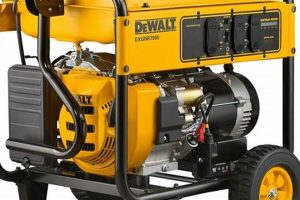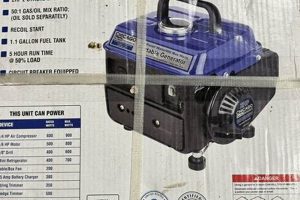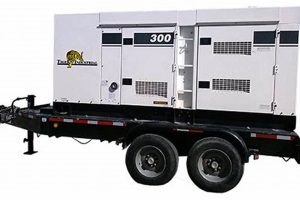A compact, mobile power source capable of producing 5 kilovolt-amperes is a valuable tool for various applications. This output typically translates to around 4 kilowatts of usable power for running common electrical devices. Such units are frequently employed at construction sites, outdoor events, or as backup power during outages, offering a convenient and reliable source of electricity where grid access is limited or unavailable.
The availability of independent electricity offers significant advantages in numerous situations. From ensuring business continuity during power disruptions to facilitating operations in remote locations, these compact power sources offer crucial support. Historically, accessing electricity away from fixed connections posed considerable challenges. The development of portable generators has revolutionized industries and disaster relief efforts, providing vital power access when and where it is most needed. This accessible power has empowered businesses, expedited projects, and enhanced safety in off-grid environments.
This article will further explore the specifications, applications, and proper operation of such devices, offering readers a comprehensive understanding of their functionality and benefits in various contexts. Topics to be covered include selecting the correct unit size, essential safety precautions, maintenance procedures, and fuel considerations.
Tips for Operating a 5 kVA Portable Generator
Safe and efficient operation of portable generators requires careful consideration of several factors. The following tips offer guidance for optimal performance and longevity, as well as crucial safety precautions.
Tip 1: Calculate Power Requirements: Determine the wattage required to run all intended devices. Adding individual wattages ensures the generator can handle the load. Operating a generator beyond its capacity can cause damage.
Tip 2: Proper Grounding: Grounding the generator protects against electrical shock. Consult local electrical codes for grounding requirements and procedures.
Tip 3: Ventilation is Key: Generators produce carbon monoxide, a colorless, odorless, and poisonous gas. Operate the generator in a well-ventilated area, far from doors, windows, and vents.
Tip 4: Fuel Safety: Allow the generator to cool completely before refueling. Store fuel in approved containers away from the generator and any ignition sources. Never refuel a running or hot generator.
Tip 5: Regular Maintenance: Adhere to the manufacturer’s recommended maintenance schedule. Regular oil changes, air filter cleaning, and spark plug replacement are crucial for optimal performance and longevity.
Tip 6: Dry Location is Essential: Protect the generator from rain and moisture. Operating a generator in wet conditions can create electrical hazards.
Tip 7: Connection Procedures: Use heavy-duty, outdoor-rated extension cords appropriate for the generator’s output. Avoid overloading circuits and ensure proper connection to appliances.
Tip 8: Professional Inspection: Periodically, have a qualified technician inspect the generator for potential issues and ensure it operates safely and efficiently.
Adhering to these guidelines ensures safe and effective power generation. Proper operation not only prolongs the lifespan of the equipment but also safeguards users and the surrounding environment.
By understanding and implementing these essential tips, users can maximize the benefits of portable power generation while minimizing potential risks. This responsible approach ensures reliable power availability and contributes to a safer operational environment.
1. Power Output
Power output is a critical factor when considering a 5 kVA portable generator. Understanding this specification is crucial for selecting the right generator to meet specific power demands. This section explores the nuances of power output concerning 5 kVA portable generators, focusing on practical implications.
- Rated Power vs. Usable Power
A 5 kVA generator has a rated power output of 5 kilovolt-amperes. However, the actual usable power, often measured in kilowatts (kW), is typically lower due to the power factor. This factor accounts for the difference between apparent power (kVA) and real power (kW). For most applications, assuming a power factor of 0.8, a 5 kVA generator provides approximately 4 kW of usable power. Accurately calculating the required wattage for connected devices is essential to avoid overloading the generator.
- Starting and Running Wattage
Electrical devices often require a higher surge of power to start than they do to run continuously. This distinction is crucial when sizing a generator. Motor-driven appliances, such as refrigerators or air conditioners, have significantly higher starting wattage requirements. The generator must accommodate both the running wattage of all devices and the highest starting wattage of any individual device. Failure to account for starting wattage can lead to the generator tripping or failing to start the appliance.
- Load Management
Effective load management optimizes generator performance and prevents overload. Prioritizing essential devices and staggering their operation can prevent exceeding the generator’s capacity. For example, running power-hungry appliances like air conditioners and electric heaters at separate times distributes the load effectively. Understanding the power requirements of individual devices allows for informed load management decisions.
- Impact of Overloading
Overloading a generator can lead to several negative consequences. These include overheating, voltage fluctuations, damage to the generator or connected devices, and potential safety hazards. Continuously operating a generator beyond its capacity significantly reduces its lifespan. Properly sizing the generator and managing the connected load are crucial for safe and efficient operation.
Selecting the correct 5 kVA portable generator requires careful consideration of power output in relation to the intended application. Understanding the distinction between kVA and kW, accounting for starting and running wattages, and implementing effective load management strategies are crucial for maximizing generator performance and longevity while ensuring safe operation.
2. Portability
Portability is a defining characteristic of 5 kVA portable generators, directly influencing their usability and application across diverse scenarios. The compact design and relatively lightweight construction of these units facilitate easy transportation and maneuverability. This inherent portability expands the potential use cases significantly, offering power solutions where stationary generators are impractical or impossible. Consider a construction site where power needs shift frequently; a portable generator can be readily relocated to power different tools and equipment as the project progresses. Similarly, during outdoor events or emergencies, portability ensures power access in locations without readily available grid connections.
The practical significance of portability extends beyond mere convenience. In disaster relief efforts, portable generators provide critical power for essential services like communication and medical equipment. For businesses, portable generators serve as reliable backup power sources, mitigating downtime during outages. The ability to quickly deploy power in remote areas supports various industries, from telecommunications to environmental research. Furthermore, the portability of these units allows individuals to enjoy power access for recreational activities like camping or tailgating. The range of applications underscores the vital role portability plays in enhancing functionality and accessibility to power.
While portability offers significant advantages, it’s crucial to consider the practical limitations. The size and weight, even in “portable” models, necessitate appropriate transportation methods. Maneuvering these units often requires more than one person, especially across uneven terrain. Furthermore, the portability factor can influence the overall design and features. Compactness may necessitate trade-offs in fuel tank size, impacting runtime. Understanding these practical considerations allows users to select the most suitable generator for their specific needs and plan for its effective deployment. Careful evaluation of portability alongside other key features ensures optimal utilization and maximizes the benefits of this crucial characteristic.
3. Fuel Type
Fuel type is a critical consideration when selecting a 5 kVA portable generator. The choice of fuel directly impacts the generator’s runtime, operating costs, maintenance requirements, and environmental impact. Understanding the advantages and disadvantages of different fuel types is essential for informed decision-making.
- Gasoline
Gasoline is a commonly used fuel for portable generators due to its wide availability and ease of use. Gasoline-powered generators typically offer a good balance between cost and performance. However, gasoline has a limited shelf life and can degrade over time, potentially causing engine problems. Additionally, gasoline engines require more frequent maintenance, including spark plug replacements and carburetor cleaning. While gasoline offers convenient refueling, its price fluctuations can impact operating costs.
- Propane
Propane offers a cleaner-burning alternative to gasoline, resulting in reduced emissions and longer engine life. Propane also has a longer shelf life than gasoline, making it suitable for long-term storage. Propane-powered generators often require less frequent maintenance compared to gasoline counterparts. However, propane requires specialized tanks and connections, and its availability can be limited in some areas. While propane burns cleaner, it typically produces slightly less power output compared to gasoline for the same generator size.
- Diesel
Diesel-powered generators are known for their durability, fuel efficiency, and long operating life. Diesel fuel is less flammable than gasoline or propane, offering enhanced safety. Diesel engines also tend to require less maintenance. However, diesel generators are typically more expensive to purchase and can be louder during operation. Diesel fuel can also gel in cold temperatures, posing challenges in certain climates. The higher initial investment in a diesel generator can be offset by its lower operating costs and extended lifespan.
- Dual Fuel
Dual-fuel generators offer increased flexibility by allowing operation on either gasoline or propane. This adaptability provides users with fuel options depending on availability and cost. Dual-fuel generators offer a level of redundancy in emergency situations. However, they often require separate tanks and connection systems for each fuel type, adding to the complexity. Performance characteristics may vary depending on the fuel used. Understanding the specific capabilities of the generator on each fuel type is crucial.
The selection of fuel type significantly influences the overall performance, cost-effectiveness, and practicality of a 5 kVA portable generator. Careful consideration of fuel availability, operating environment, required runtime, and budget constraints is essential for choosing the optimal fuel source. Matching the fuel type to the specific application ensures reliable power generation and maximizes the benefits of the portable generator.
4. Applications
The versatility of 5 kVA portable generators makes them suitable for a wide range of applications across various sectors. Understanding these applications provides insights into the practical utility and benefits of these power sources. The specific power output of a 5 kVA generator positions it ideally for scenarios requiring moderate power levels, striking a balance between portability and capacity. This balance is crucial for bridging the gap between smaller, less powerful portable generators and larger, less mobile stationary units.
In construction and contracting, 5 kVA portable generators power tools and equipment on sites without grid access. This facilitates project completion in remote areas or during initial construction phases before permanent power is established. For small businesses, these generators provide backup power during outages, ensuring business continuity and preventing data loss. This reliability is crucial for maintaining operations and minimizing financial losses due to power disruptions. Homeowners also benefit from 5 kVA portable generators during extended power outages, providing essential power for lighting, refrigeration, and heating systems. This capability enhances safety and comfort during emergencies. Outdoor events, such as festivals and concerts, leverage these generators to power lighting, sound systems, and vendor stalls, enhancing the overall experience. The portability factor allows for flexible power deployment across various event layouts.
Furthermore, the applications of 5 kVA portable generators extend to emergency services and disaster relief efforts. Providing power for essential communication systems, medical equipment, and temporary shelters, these generators play a crucial role in mitigating the impact of natural disasters. In remote areas, they power off-grid cabins, research stations, and telecommunications infrastructure. This enables operations in locations far from established power grids, expanding possibilities for scientific exploration, environmental monitoring, and rural development. Understanding the diverse applications of 5 kVA portable generators allows for effective utilization and deployment in scenarios where reliable and portable power is essential. This adaptability makes them valuable tools for various industries, emergency services, and individual users.
5. Maintenance
Maintenance is essential for the longevity and reliable operation of a 5 kVA portable generator. Neglecting routine maintenance can lead to decreased performance, premature failure, and potential safety hazards. Regular maintenance schedules, tailored to the manufacturer’s recommendations, ensure optimal function and extend the generator’s lifespan. A well-maintained generator provides consistent power output when needed, reducing the risk of unexpected downtime. For instance, neglecting oil changes can lead to engine wear and eventual failure, potentially incurring costly repairs. Regular maintenance mitigates such risks.
Several key maintenance tasks contribute to the overall health of a 5 kVA portable generator. Regular oil changes, using the recommended oil type and viscosity, ensure proper lubrication and prevent engine damage. Air filter cleaning or replacement prevents dust and debris from restricting airflow, which can impact combustion efficiency and engine performance. Spark plug inspection and replacement maintain consistent ignition and optimal fuel combustion. Fuel system maintenance, including draining old fuel and checking for leaks, prevents fuel degradation and ensures reliable starting. These procedures, though seemingly simple, play a crucial role in maximizing the generator’s operational lifespan and reliability. Furthermore, adhering to recommended maintenance intervals prevents the accumulation of minor issues that can escalate into major repairs.
Understanding the direct correlation between maintenance and performance is crucial for maximizing the return on investment in a 5 kVA portable generator. Regular maintenance not only prevents costly repairs but also ensures reliable power delivery when needed. This reliability is particularly critical in emergency situations or when the generator serves as the primary power source. A proactive approach to maintenance minimizes downtime and extends the generator’s operational life, contributing to long-term cost savings and dependable performance. This proactive approach ensures the generator remains a reliable power source, ready to meet demands whenever required.
Frequently Asked Questions
This section addresses common inquiries regarding 5 kVA portable generators, providing concise and informative responses to facilitate informed decision-making and proper usage.
Question 1: How much power can a 5 kVA portable generator actually provide?
While the generator’s rating is 5 kVA (kilovolt-amperes), the usable power output is typically around 4 kW (kilowatts) due to the power factor. This usable power is what can be reliably drawn for operating electrical devices.
Question 2: What type of fuel is most commonly used in these generators?
Gasoline is the most common fuel type due to its widespread availability. However, propane and diesel options are also available, each with its own advantages and disadvantages regarding cost, storage, and emissions.
Question 3: How long can a 5 kVA portable generator run continuously?
Runtime depends on several factors, including fuel tank capacity, load size, and engine efficiency. Typical runtimes range from several hours to over ten hours at half load. Consulting the manufacturer’s specifications provides precise runtime estimates for specific models.
Question 4: What safety precautions are essential when operating a portable generator?
Operating a generator outdoors in a well-ventilated area is crucial to prevent carbon monoxide poisoning. Proper grounding is essential to avoid electrical shock. Allowing the generator to cool before refueling is vital for fire safety.
Question 5: How often should a 5 kVA portable generator be serviced?
Adhering to the manufacturer’s recommended maintenance schedule is essential for optimal performance and longevity. This typically includes regular oil changes, air filter cleaning or replacement, and spark plug checks.
Question 6: Can a 5 kVA portable generator power a house during an outage?
A 5 kVA generator can power essential household appliances and circuits during an outage. However, it may not be sufficient to run all devices simultaneously. Prioritizing essential loads and managing power consumption is crucial.
Understanding these key aspects of 5 kVA portable generators facilitates informed selection, safe operation, and proper maintenance. Careful consideration of power requirements, fuel type, and safety precautions ensures effective utilization and maximizes the generator’s lifespan.
For further information on specific models and technical specifications, consult manufacturer resources or authorized dealers. This additional research ensures selection of the most appropriate generator for individual needs and applications.
Conclusion
Careful consideration of power requirements, fuel type, portability, applications, and maintenance needs are essential for maximizing the benefits of a 5 kVA portable generator. Understanding these aspects allows for informed selection and ensures the chosen unit aligns with specific power demands and operational contexts. From construction sites and emergency services to residential backup power and outdoor events, these versatile power sources play a crucial role in providing reliable electricity where grid access is limited or unavailable. Regular maintenance, coupled with adherence to safety guidelines, ensures long-term performance and safe operation, maximizing the return on investment and mitigating potential hazards.
Investing in a 5 kVA portable generator represents a commitment to power accessibility and preparedness. This investment offers a valuable resource for various applications, providing a reliable power solution for diverse needs. Careful selection, informed operation, and diligent maintenance ensure this power source remains a dependable asset, ready to deliver when required. The continued development and refinement of portable generator technology promise further advancements in efficiency, portability, and environmental impact, enhancing their utility and solidifying their role as essential power solutions for the future.






